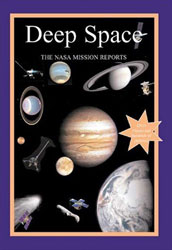
Deep Space – The NASA Mission Reports. Click to enlarge.
With the maturing of space flight in the 1960’s, NASA could set goals loftier than clambering around Earth’s nearest satellite for a few short hours. There existed the ability to travel anywhere in the solar system, take measurements and view the results. Grabbing this opportunity with both hands, NASA launched:
? the Pioneer 10 and 11 crafts on two missions to Jupiter,
? the Voyager 1 and 2 crafts on two missions to Jupiter, Saturn and beyond,
? the Galileo craft on a mission to Jupiter,
? the Cassini-Huygens craft on a mission to Saturn,
? the Deep Space 1 craft on a mission to comet 19P/Borrelly, and
? the Stardust craft on a mission to comet Wild-2.
Nominally each was to expand our knowledge of the solar system and to better understand our relative place within it.
NASA, as typical for all government bureaucracies, dutifully printed up extensive documentation for each mission. From these, the book provides reproductions of press kits, special reports, status reports and fact sheets. The press kits predominate. They describe the craft, the mission, current activities, any extenuating circumstances and expectations just prior to critical moments. Typically, one kit gives a pre-launch summary and others give a summary just before the first encounter of a target. The kits are quite detailed with break downs of the components and functions of each spacecraft. Descriptions of the purpose and equipment for each science experiments clarify the purpose. The trajectory, navigation and communication elements demonstrate some challenges to be overcome. Lists of project managers, principal investigators and contractors ensure posterity to many participants. Thin coverage of the results is an indicator that, though NASA ran the missions and wrote many transcripts, there were others that promulgated the results in their own distinct fashion.
The enclosed DVD shows how NASA has leapt into the new media of video. Audio/video footage from NASA TV and other NASA sources show boosters lofting payloads up and away. During final countdown, often a lengthy time of apparent inactivity, images of trucks and transport aeroplanes delivering components liven up the proceedings. Clean room activities, such as checking solar arrays and mating components, give some insight into preflight activities. Video results of encounters particularly reward viewers. A wonderful segment shows a complete 360 degree coverage of the tumbling asteroid Eros from a very close perspective. Voyager’s visual imagery of the swirling storms on Jupiter transfix the eye and certainly credit the usage of video as a strong communication media.
With the inclusion of all these deep space missions, the editors Godwin and Whitfield provide a marvellous resource for reviewing any deep space mission. Further, by proceeding in a chronological order, the reader can easily grasp how results of an earlier mission influenced the investigations of the following one. From the Pioneer mission, where transit of the asteroid belt came with much misgivings, to Cassini-Huygens dropping a capable probe onto a moon of Saturn, the press kits look the same but the contents just keep getting better.
One thing about having dual missions like Pioneer 10 and 11 or Voyager 1 and 2 is that a lot of similarity exists. The same must be said for their press kits. Though the editors appear to have tried to remove some repetitive verbiage, there are still many tracts, drawings and lists that appear time and again in the book. This is true whether the kits are for different moments of the same mission or of related missions. Also, in keeping with government-eze, just about all the dissertation blandly recites facts and figures. Qualitative descriptors are few and far between. Regarding the DVD, the short 8 page PDF file for Galileo seems an injustice especially considering the 100’s of pages and videos for both Pioneer and Voyager.
One truly rewarding decisions created NASA as a non-military organization. In consequence, they hide little in the quest to learn more about the universe in which we live. The book Deep Space – The NASA Mission Reports as edited by Robert Godwin and Steve Whitfield compiles the very detailed official announcements from NASA for their missions that travelled beyond Mars. In it, facts, figures, data and images corroborate our new awareness and appreciation of our planetary neighbourhood.
Order a copy online from Countdown Creations or Amazon.com.
Review by Mark Mortimer
